Land InSight: A Digital Twin for UK soils
UKCEH is developing a digital twin of UK soils to improve our understanding of soil moisture and soil carbon and decision making around climate impacts (flooding and drought) and Net Zero (increasing the uptake of carbon by soils).
Land InSight will:
- Bring together a wide range of soil observations, from in situ monitoring networks and remote sensing, with models of the land surface and soils
- Produce real-time predictions of soil states, combining observations with state-of the-art models
- Bring new data science and machine learning approaches alongside process models and develop hybrid modelling approaches
- Allow scenarios of future soil states to be produced, under varying climate and land use
- Share soil information directly with end users through interactive tools
- Link with other digital twins of the environment to improve the way soils are represented in other modelling systems
The project is funded by NERC as a Digital Twin use case and is a collaboration with the British Geological Survey and British Antarctic Survey.


